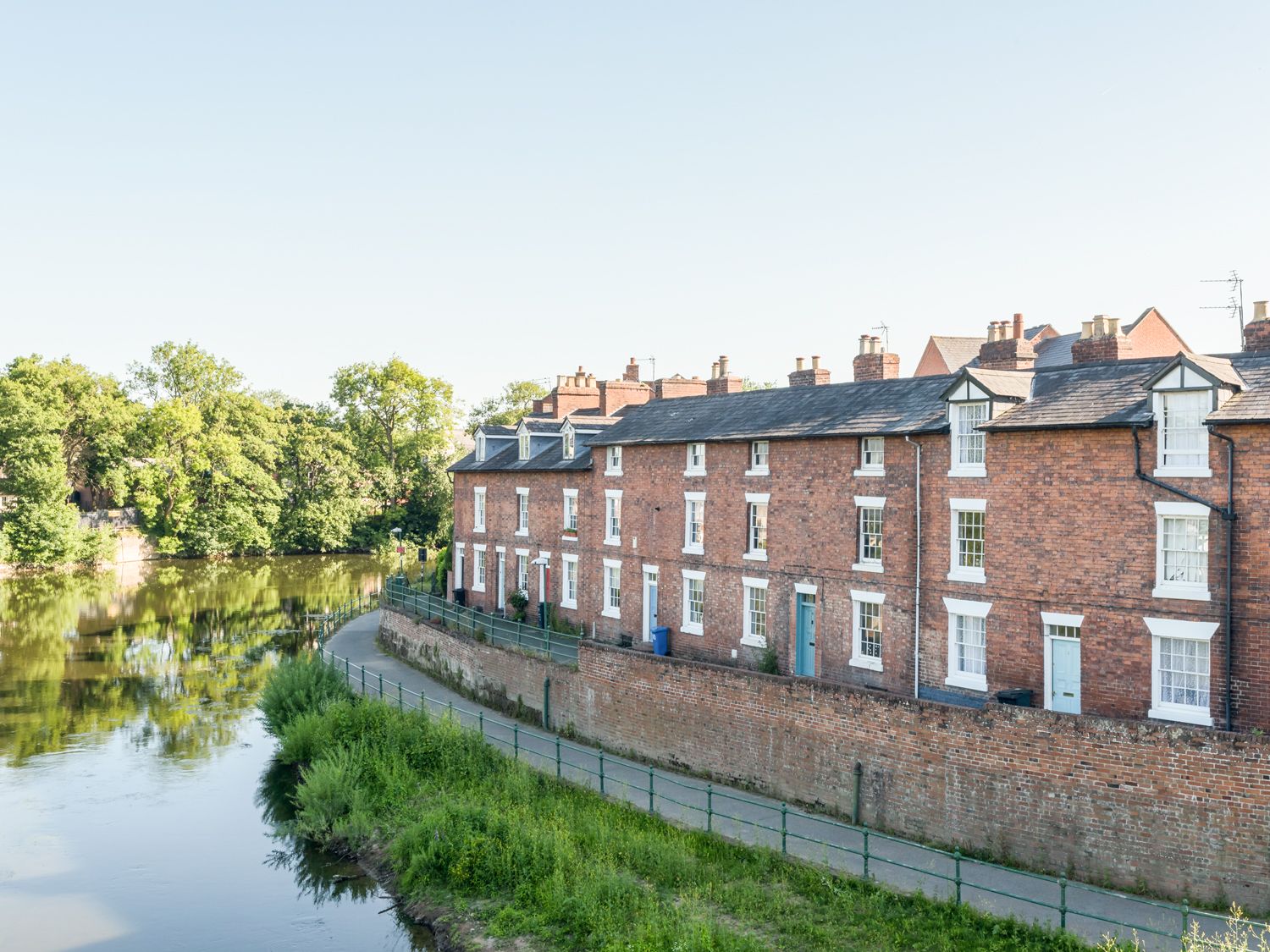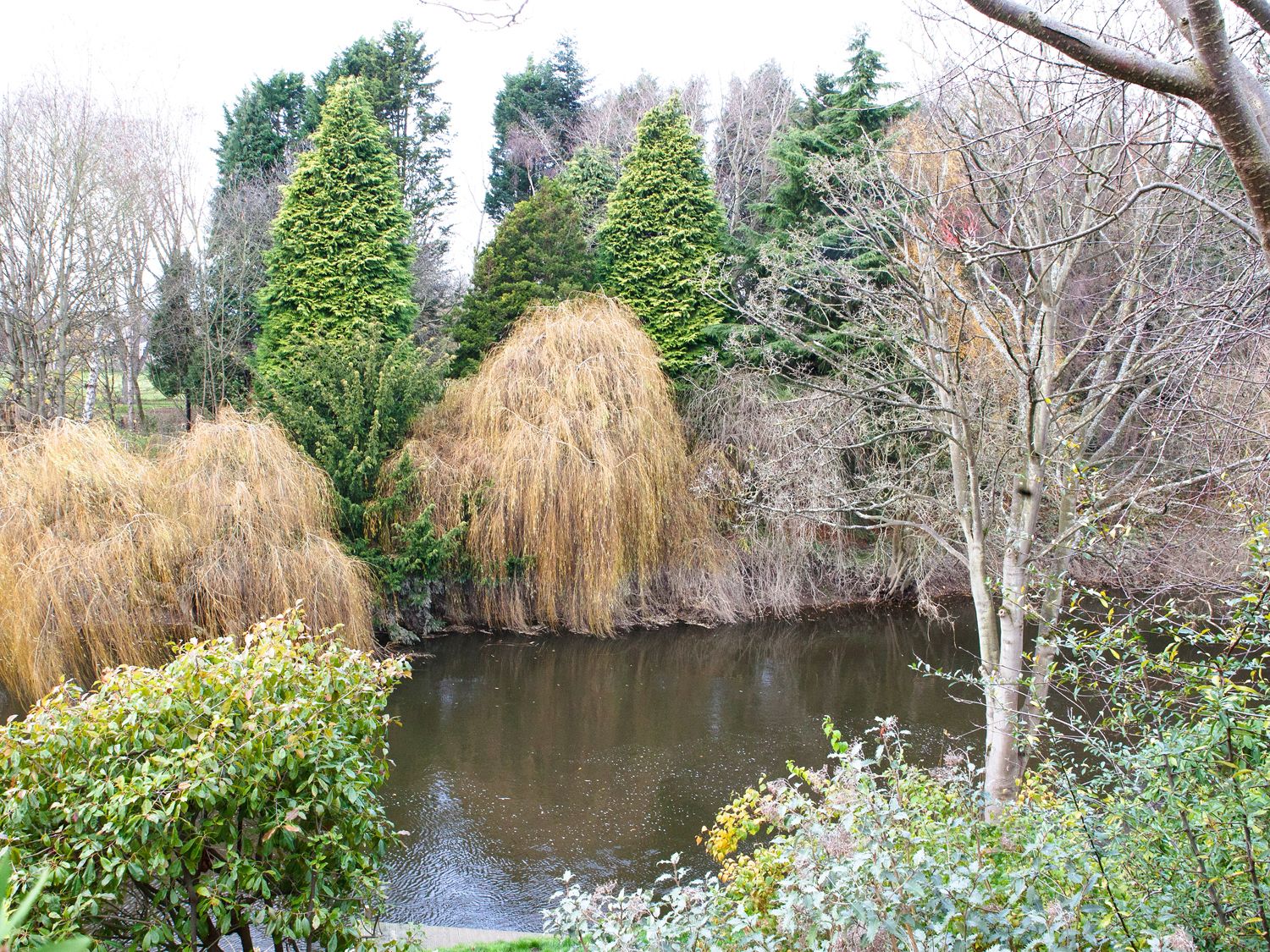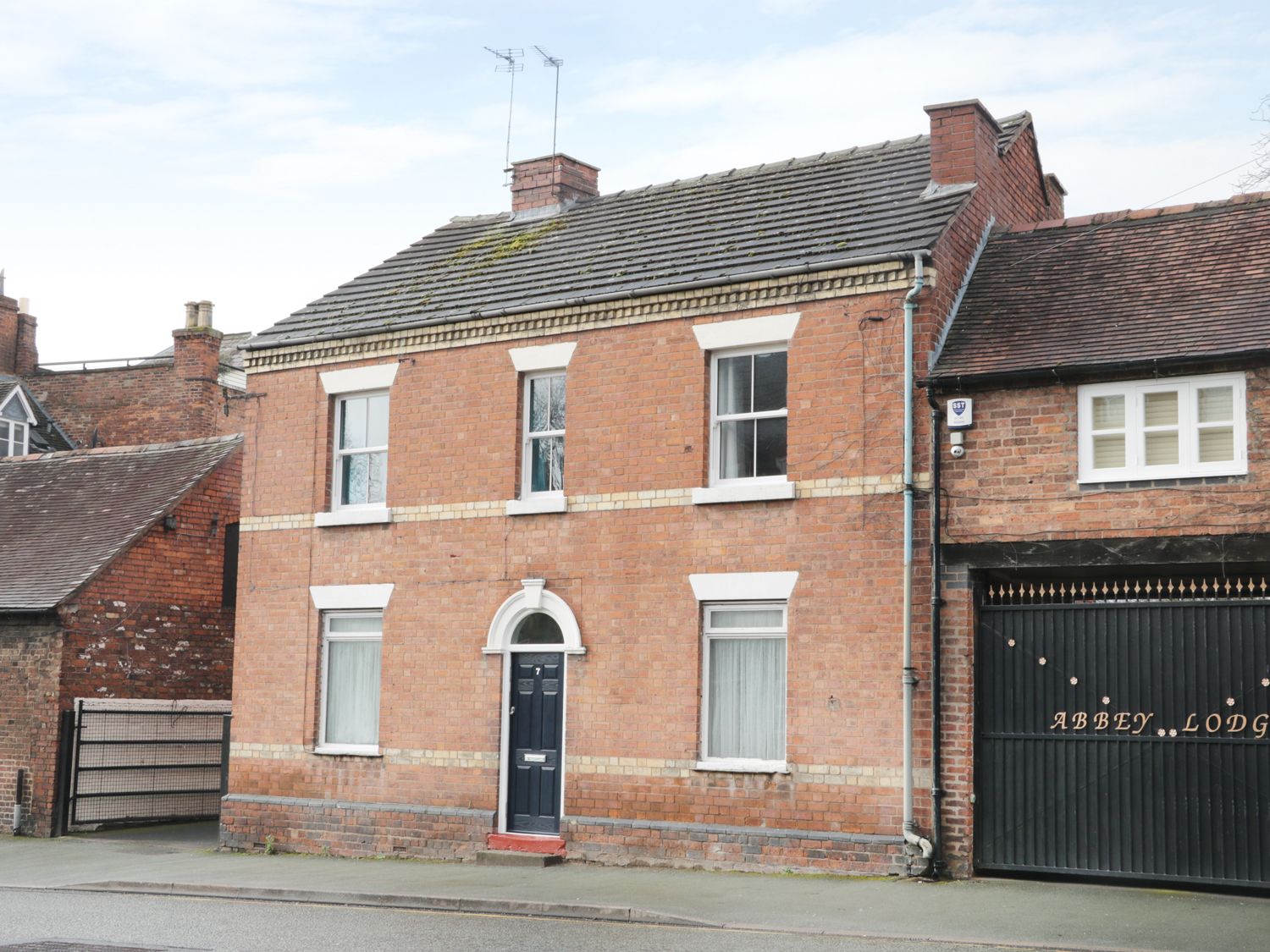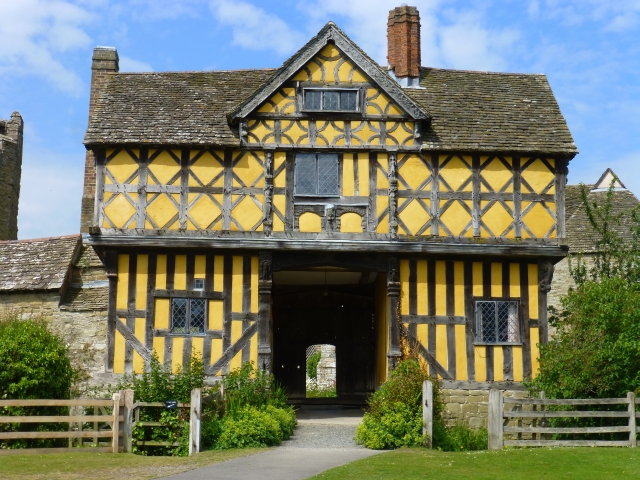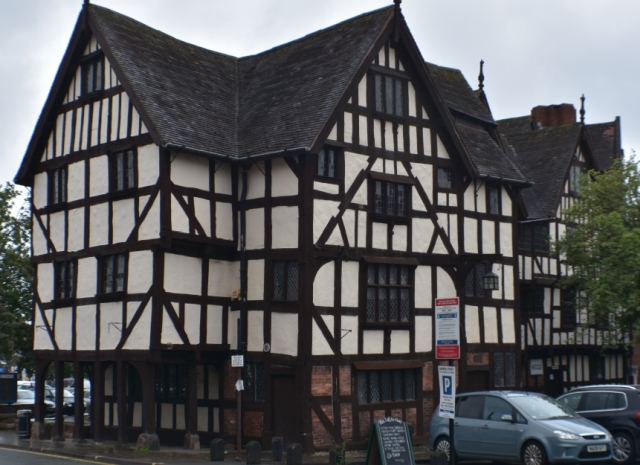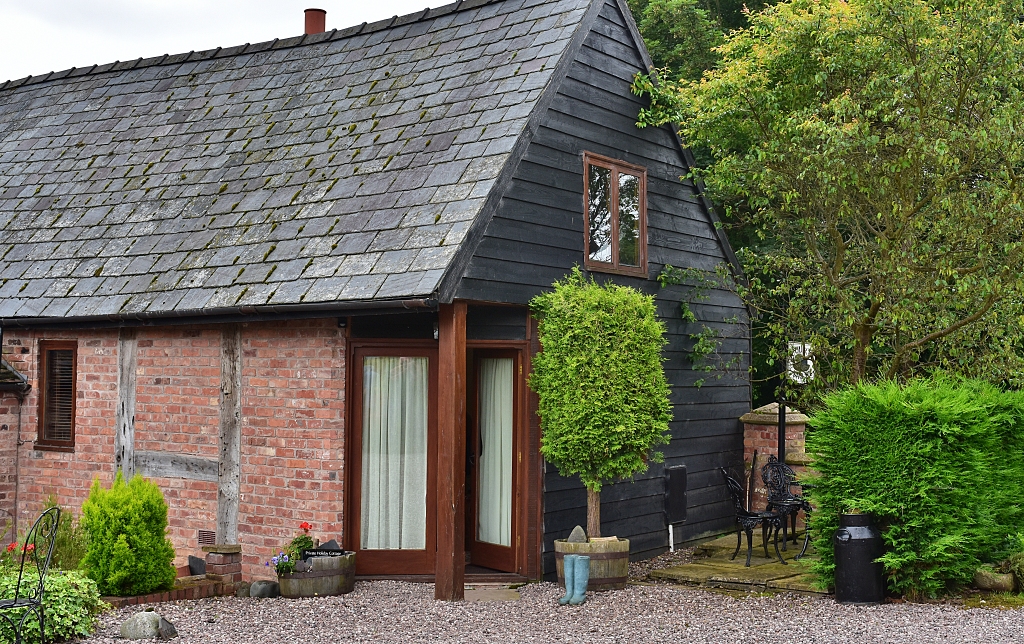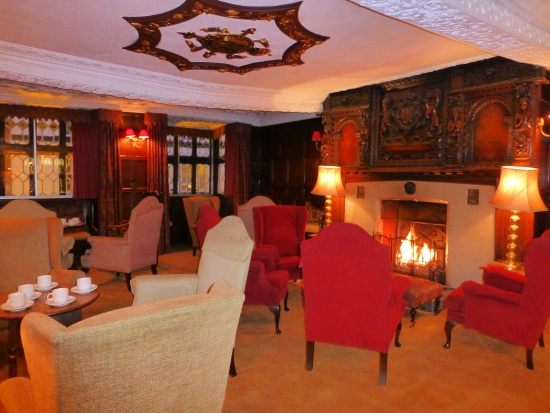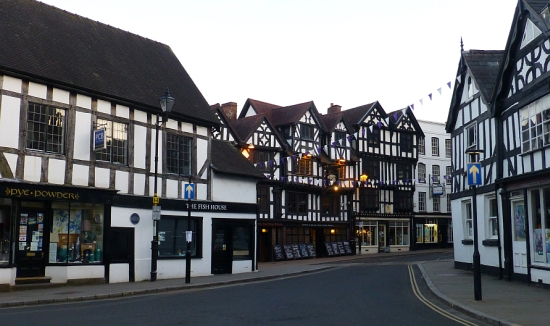Shrewsbury
Floreat Salopia
Shrewsbury is the county town of Shropshire, and according to the 2016 Visitors guide it’s been voted “the second happiest place to live in the United Kingdom”.
It’s packed with historical buildings, historic stories, and famous people. There are 600 or more listed buildings, a large number of which are from the Tudor period. Then there is the medieval town centre with its maze of narrow streets just a short stroll away from the site of a Norman castle.
And all of this is tucked into a horseshoe-shaped kink in England’s longest river, the River Severn.
The town's layot is compact, so it is very easy to walk around, and being in town means that if it happens to be a wet day like the day we visited, you can always dive into somewhere warm and dry. We parked just outside of the town centre, opposite Shrewsbury Abbey and started our tour from here.
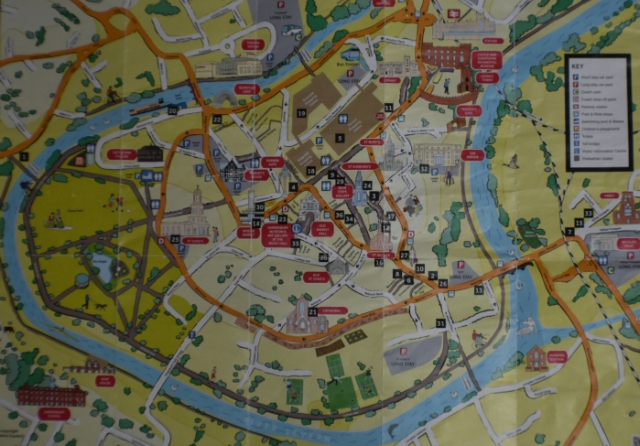 Town Map © essentially-england.com
Town Map © essentially-england.comAfter visiting Shrewsbury Abbey you can cross English Bridge, turn right to walk beside the River Severn and then take a left through the Traitors Gate. Go up St Mary’s Water Gate Lane to the olde town centre. Freshly restored in 2016, Traitors Gate is a medieval gateway to the river and the lane towards town would have had high defensive walls. It was originally named St Mary’s Gate, but during the Civil War the gate was opened by a traitor to allow the Parliamentary army in to the Royalist stronghold.
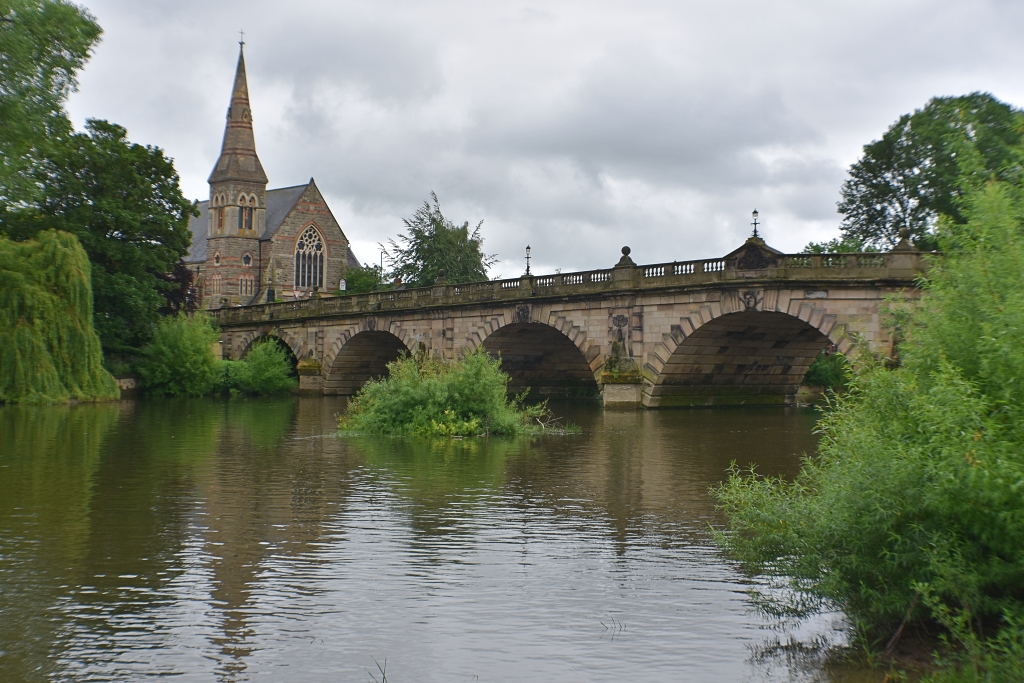 English Bridge © essentially-england.com
English Bridge © essentially-england.com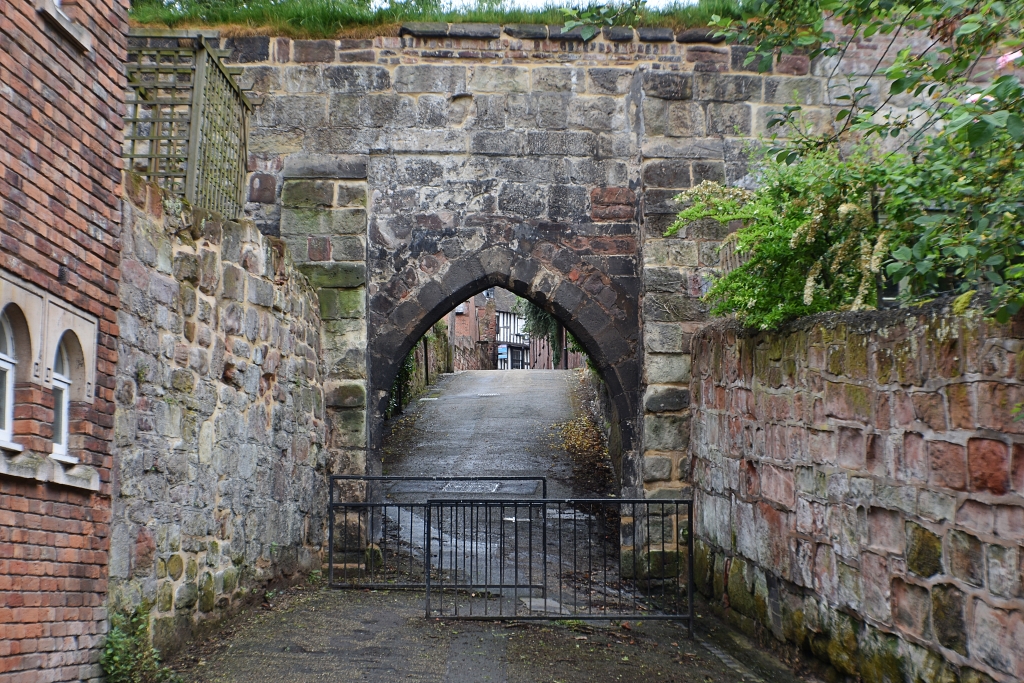 Traitors Gate © essentially-england.com
Traitors Gate © essentially-england.com
The Medieval Quarter - The Shuts
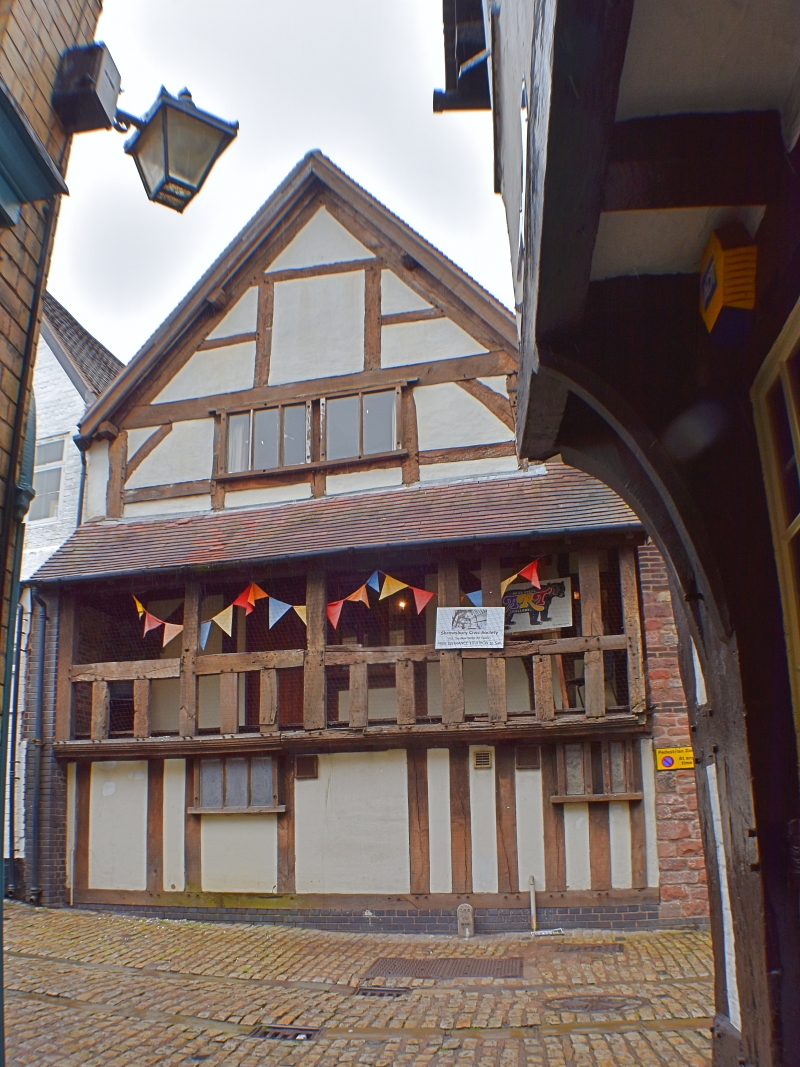 In the Shuts © essentially-england.com
In the Shuts © essentially-england.comThis is a fascinating area of Shrewsbury full of narrow medieval streets or passageways often taking their name from the trades people that used them in times gone by.
In Shropshire language these streets are called “shuts” and we found such gems as Butchers Row, Milk Street, and Grope Lane. Although the buildings have changed, these could be the streets that poor David II, the last native Prince of Wales, had been dragged through after his trial at the abbey before being hanged, drawn and quartered.
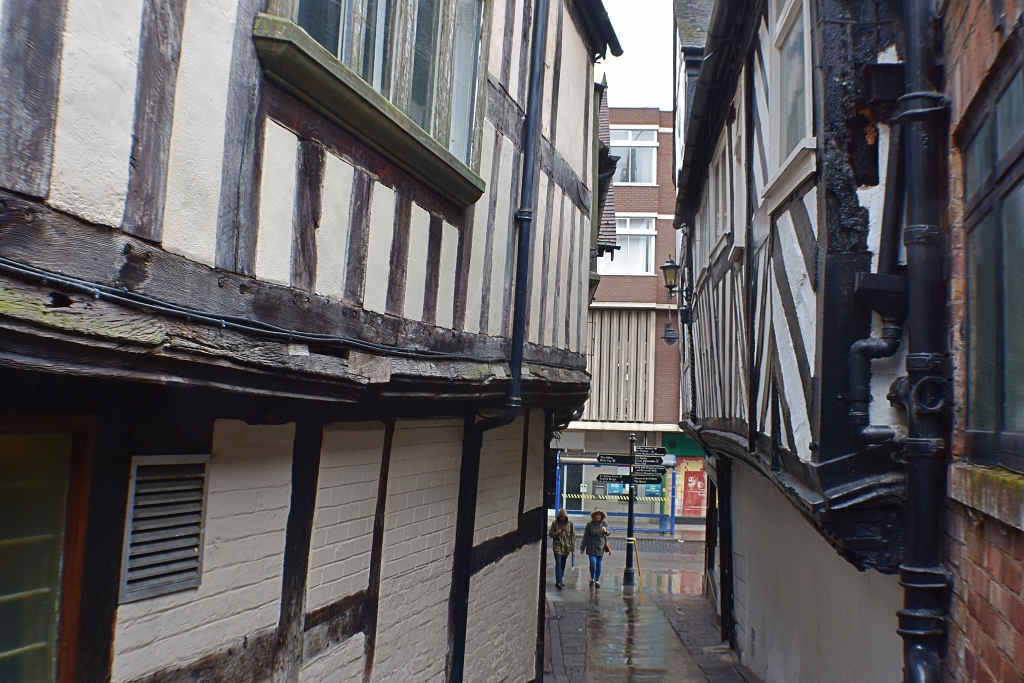 Medieval Streets © essentially-england.com
Medieval Streets © essentially-england.com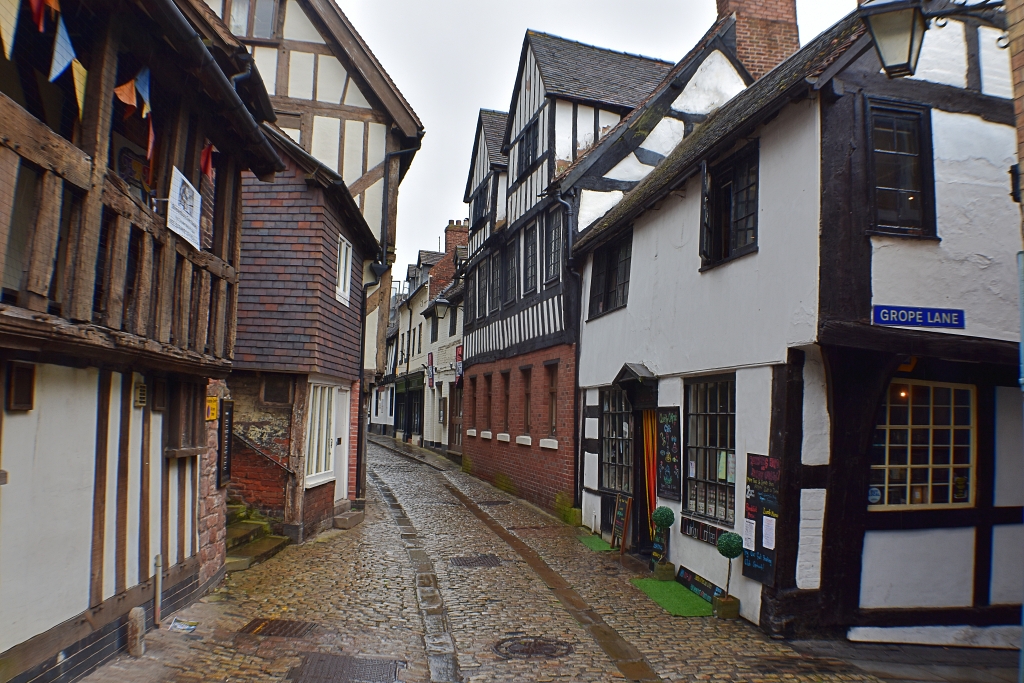 Grope Lane © essentially-england.com
Grope Lane © essentially-england.comShrewsbury Castle
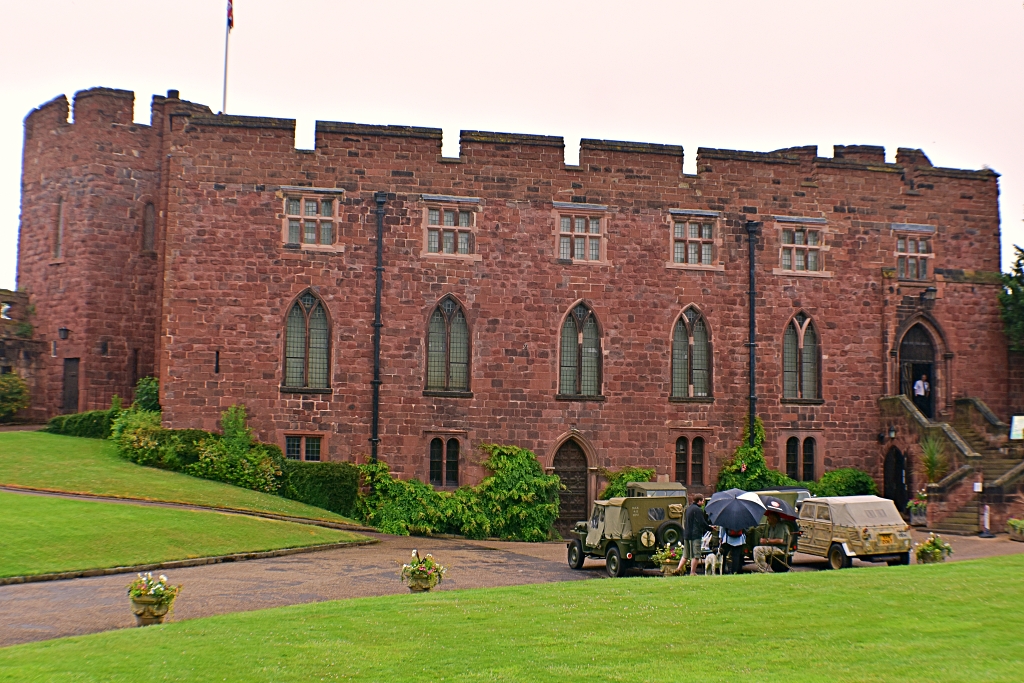 Shrewsbury Castle © essentially-england.com
Shrewsbury Castle © essentially-england.com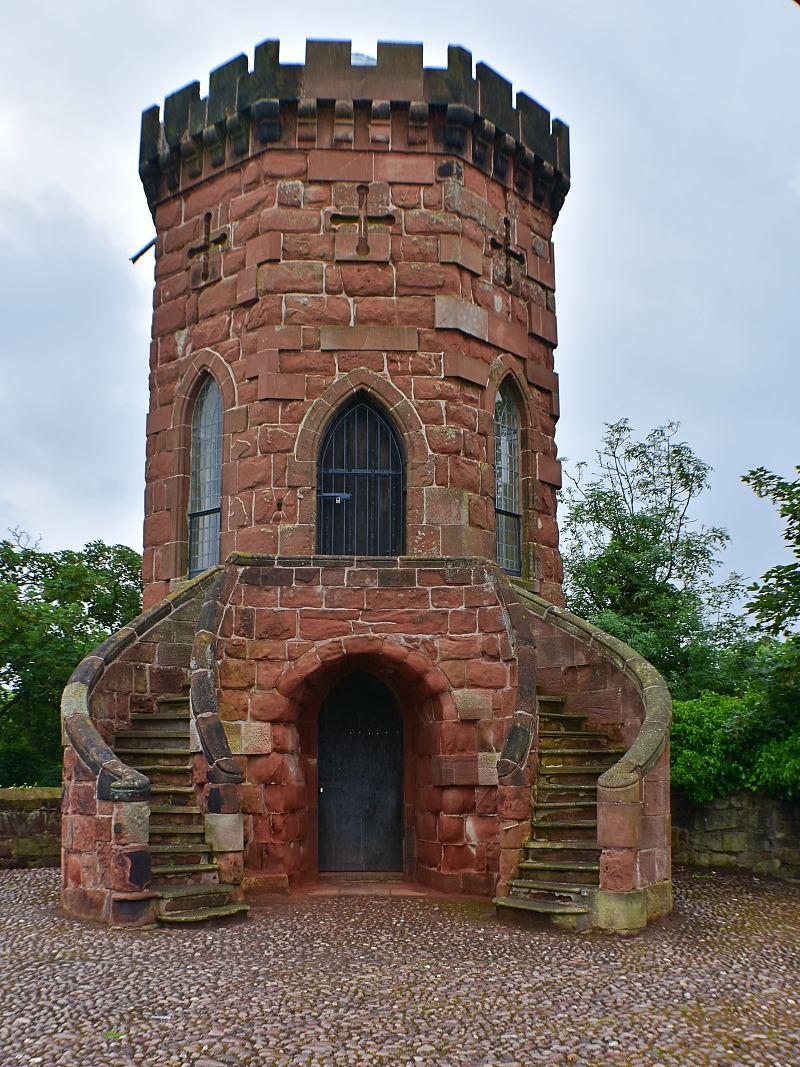 Laura's Tower © essentially-england.com
Laura's Tower © essentially-england.comThe first Norman castle would have been an earthwork motte and bailey built by Roger de Montgomery a few years after the Norman Conquest. It guarded the only landward entrance into Shrewsbury, and probably replaced a Saxon fortification. The only remains of this castle is the motte which is worth climbing to get fine panoramic views. Thomas Telford built Laura’s Tower on the mound in the eighteenth century.
The first stone castle was built by King Henry II in 1164 and the bailey was surrounded with a curtain wall. In the thirteenth century King Edward I built the great hall and strengthened the castle. The castle has been modified a number of times since, but what we see today is all based on Edward I’s great hall.
Like many others, Shrewsbury Castle has a chequered past. It’s been held by the Welsh, been left to decay, been restored, given away by Queen Elizabeth I, has seen action during the Civil War, and in 1992 was attacked by the IRA.
The castle now houses the Shropshire Regimental Museum.
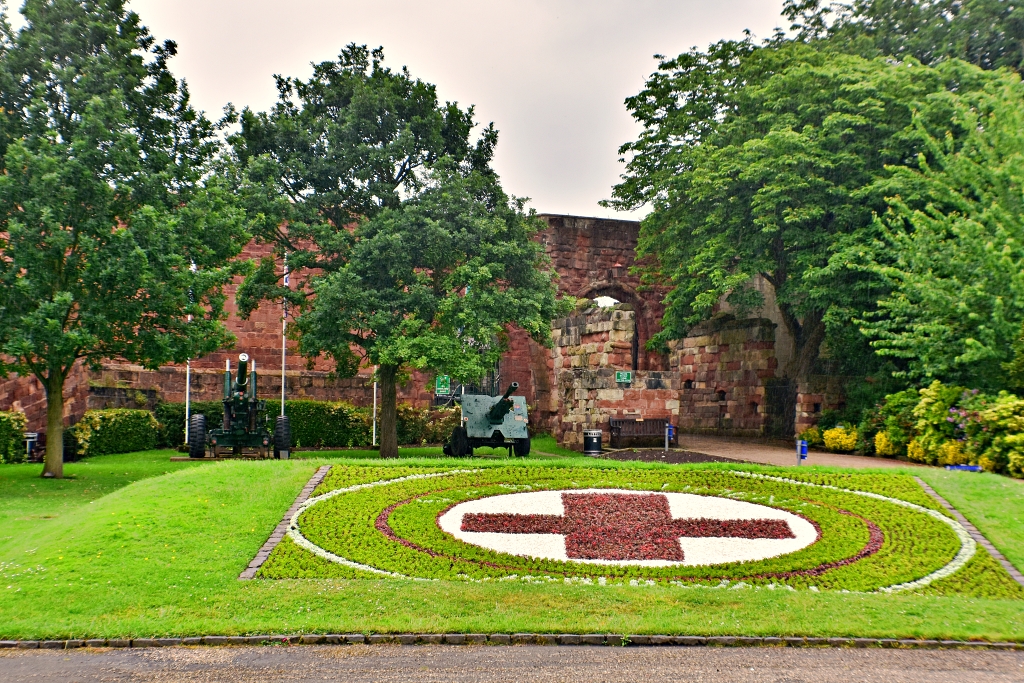 Castle Garden © essentially-england.com
Castle Garden © essentially-england.com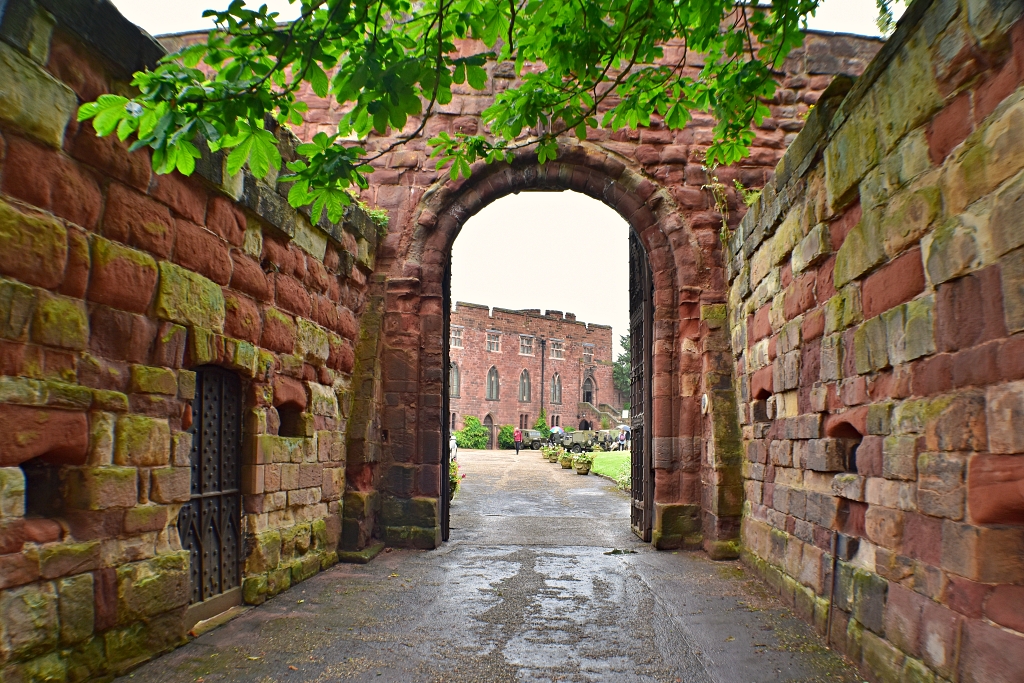 Castle Gateway © essentially-england.com
Castle Gateway © essentially-england.comJust outside the castle grounds is the impressive looking Castle Gate House with its distinctive yellow and black colouring. Believe it or not, but this house used to be situated in Dogpole - a different part of town - and in the eighteenth century it was dismantled and rebuilt in its present position by the Earl of Bradford.
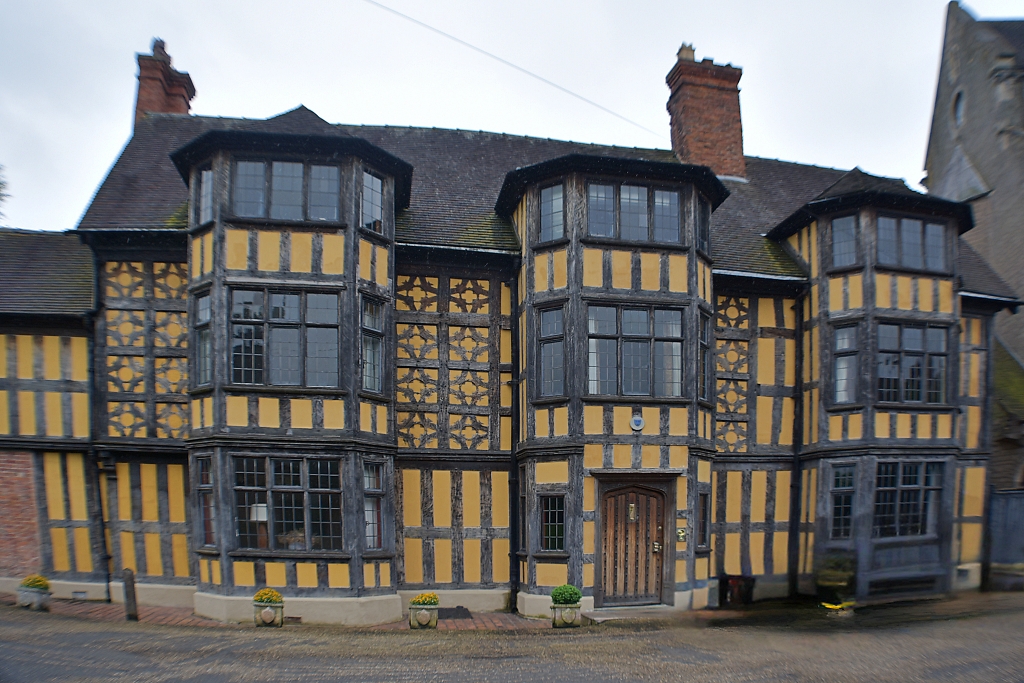 Castle Gate House © essentially-england.com
Castle Gate House © essentially-england.comCharles Darwin
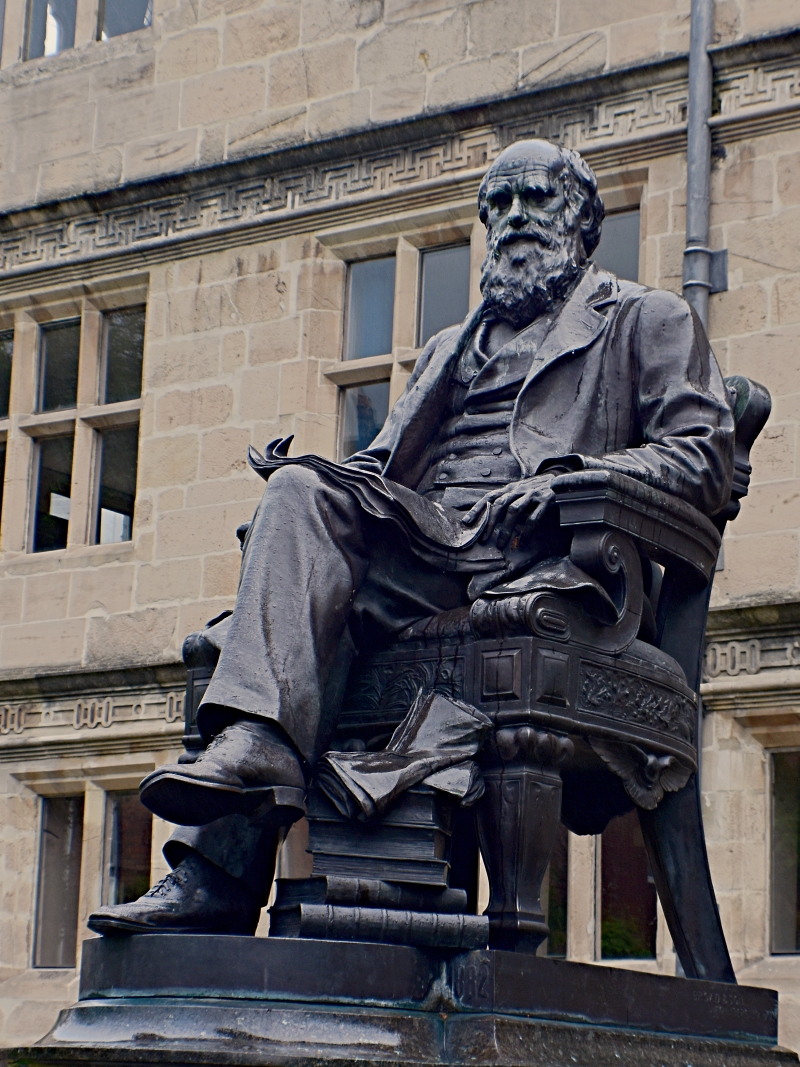 Charles Darwin © essentially-england.com
Charles Darwin © essentially-england.comJust opposite the castle is another impressive building. Once upon a time, this was Shrewsbury School, but it has been refurbished as the town's main library.
Just in front of the entrance you can find a statue of Charles Darwin who was born and educated in Shrewsbury. His interest in nature and natural history started beside the River Severn where he was often catching newts and insects. Most likely they fuelled his early fascination with evolution. A fascination that led him on a five-year voyage of discovery aboard the Beagle and finally prompted him to write about the origins of species.
The Darwin family home, Mount House, often opens its gardens for visitors to wander along his thinking trail. In February each year there is a Darwin Festival that celebrates his life and achievements.
The Town Square
At the
heart of Shrewsbury
is the town square, which is surrounded by an assortment of impressive buildings.
The Market Hall in the centre of the square was built in 1595. The ground floor was a corn market and the upper floor was used by drapers purchasing woollen cloth from Wales.
The drapers were the richest and most powerful guild in medieval Shrewsbury, and built many of the half timbered houses in town. These days, the Market Hall is used as a cinema. It's probably the smallest and most historic cinema in England, where you can sit under a Tudor beamed ceiling with a glass of wine and watch classic films.
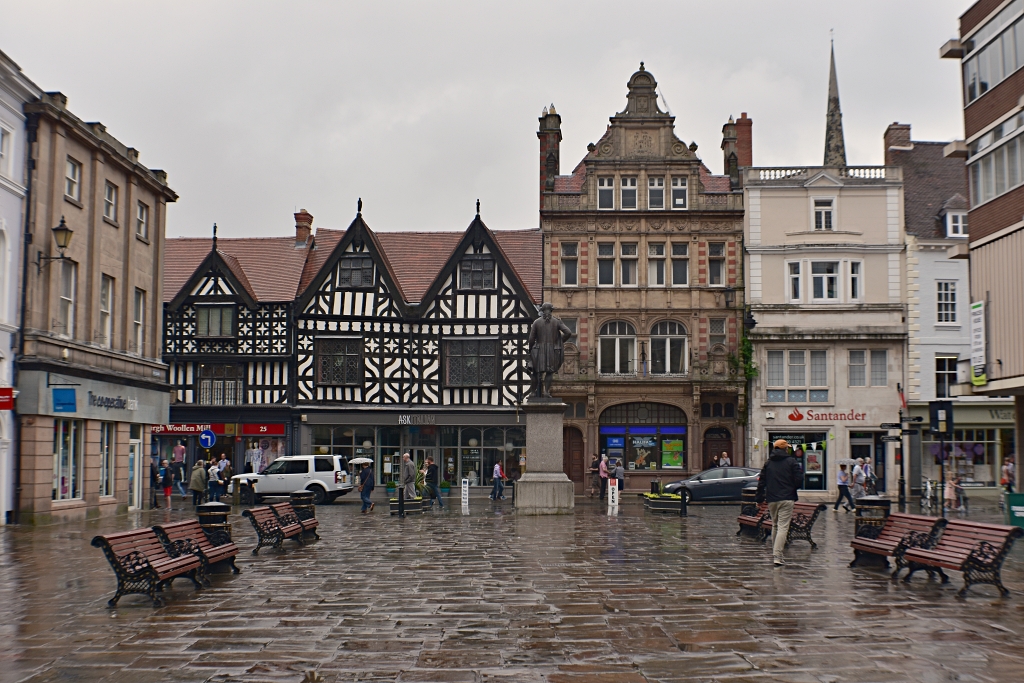 The Town Square © essentially-engalnd.com
The Town Square © essentially-engalnd.comThe area in front of the market hall used to be a pool or bog called the Bishops Pool. It was here that nagging wives or rogue traders were ducked in punishment. Or maybe in retaliation, seeing that Shrewsbury's husbands, desirous of taking out their ire on their wives, could pay one farthing per duck in the pool.
The Old Music Hall, more modern-looking than the black-and-white half-timbered buildings, is now the Shrewsbury Museum and Art Gallery. Part of this Victorian edifice is the thirteenth century Vaughan’s Mansion which is a rare surviving medieval defensive hall house.
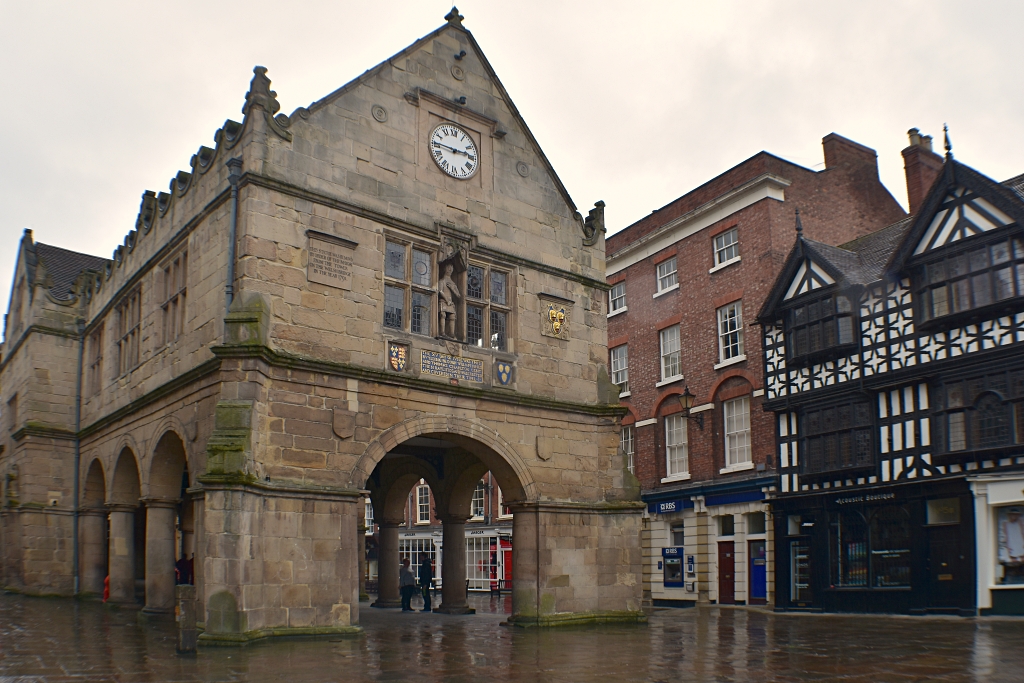 The Old Market Hall © essentially-england.com
The Old Market Hall © essentially-england.com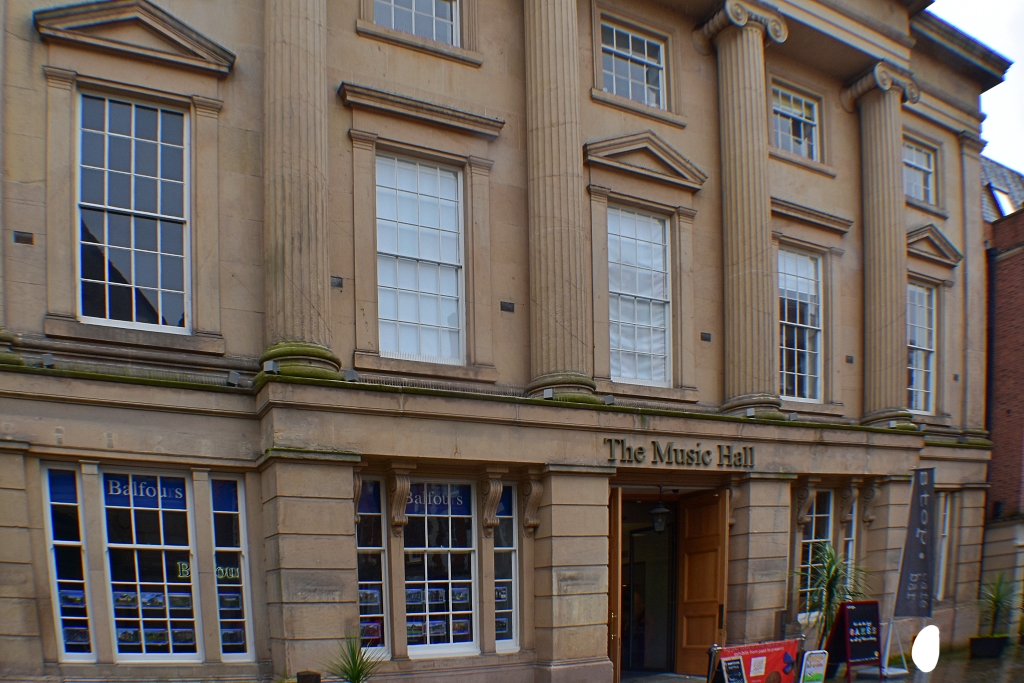 The Music Hall © essentially-england.com
The Music Hall © essentially-england.comThe Town Wall
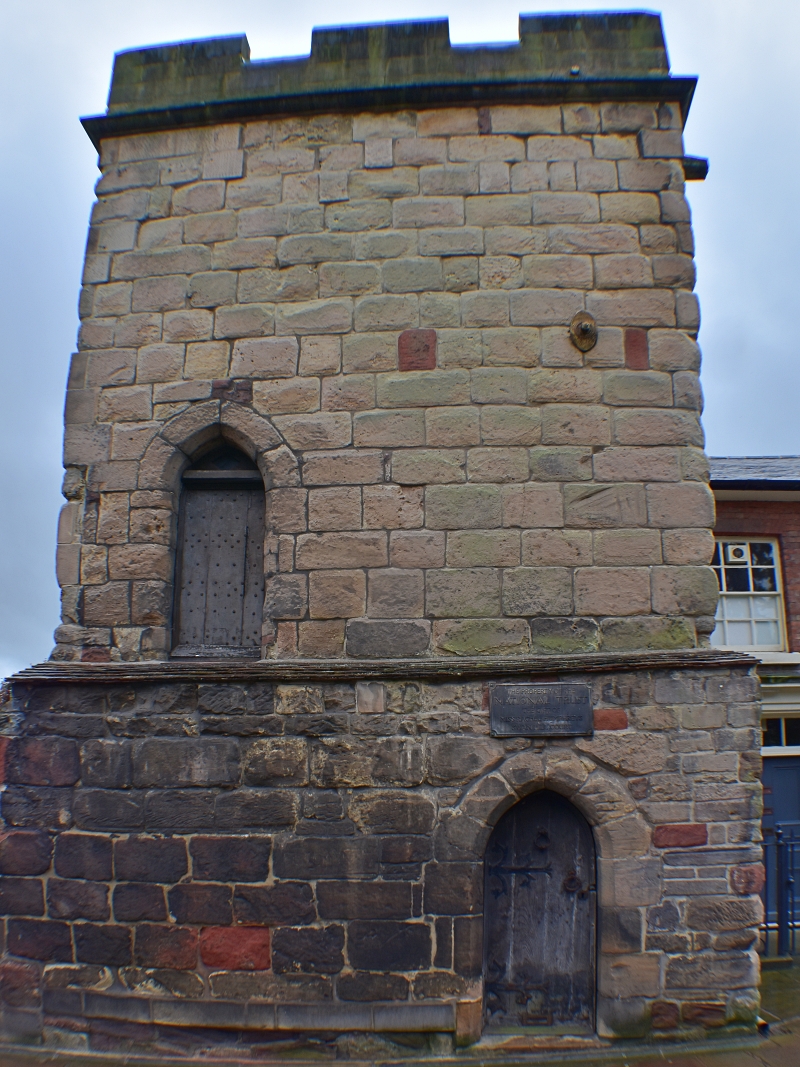 Town Wall Tower © essentially-england.com
Town Wall Tower © essentially-england.comBeing close to the Welsh border, King Henry III encouraged Shrewsbury to build fortifications by offering a number of grants to the town.
A town wall with a ditch was constructed around
1220-1242, but by the fourteenth century the wall was in a very poor state and King
Henry IV commissioned repairs and improvements. There is not much left of the
old town wall that protected the inhabitants from aggressive attackers apart
from Town Wall Tower
which is owned by the National Trust and can be rented as a holiday cottage. This would be from Henry IV’s building of
the wall.
A 1575 map of the town shows it surrounded by walls and the Traitors Gate, that we passed through at the beginning of our meander around the town, got its name from an incident during the Civil War. The Town Walls road follows the position of the old medieval town wall and runs past the Roman Catholic Cathedral which contains a number of very impressive stained glass windows.
St. Chad's Parish Church
One thing we noticed on our walk is that Shrewsbury appeared very well provided with churches! Of those, St. Chad’s was probably the most unusual. It's the parish church for the centre of town and dates back to Georgian times.
The original church on this site was founded around 780 AD by Offa, King of Mercia. The current church we see today was built between 1790 and 1792 after the older church collapsed in 1788. The design and position of the church caused much controversy at the time because it was going to have a circular nave and part of the town wall and a tower had to be demolished.
Round churches are not common and it's worth checking out St. Chad's since it has the largest round nave of any church in England. It also has some very fine church bells. A ring of 14 bells, in fact, which is the heaviest ring of bells in Shropshire.
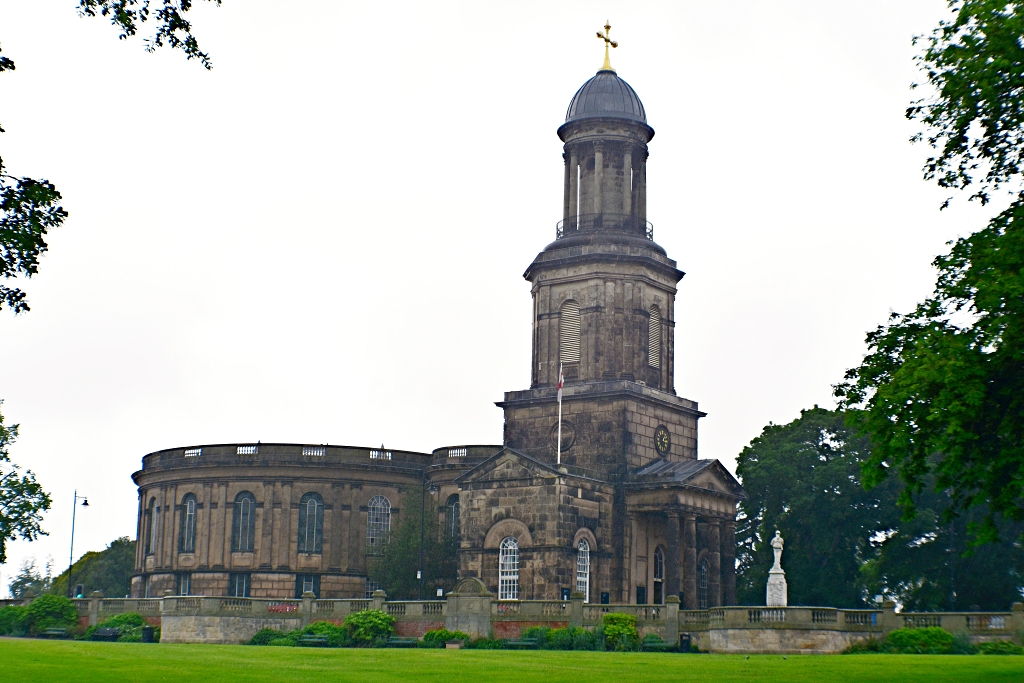 St. Chads Church in Shrewsbury © essentially-england.com
St. Chads Church in Shrewsbury © essentially-england.comAnd if you visit the graveyard you will find a tombstone for Ebeneezer Scrooge. Unfortunately, it's a prop left over from a 1983 film of A Christmas Carol.
Quarry Park
Although not historic, Quarry Park covers 29 acres of riverside parkland in the centre of Shrewsbury.
Previously this area was a stone quarry that in 1719 was converted into a beautiful park that lends itself to an afternoon's picnic on the lawn, to simply strolling along the paths to look at flowers, or to attending one of the events that take place there.
Like us, you could enter the park to the sound of jazz and swing drifting from the bandstand. It mattered little that it rained. Listening to music is just as easily done from under an umbrella.
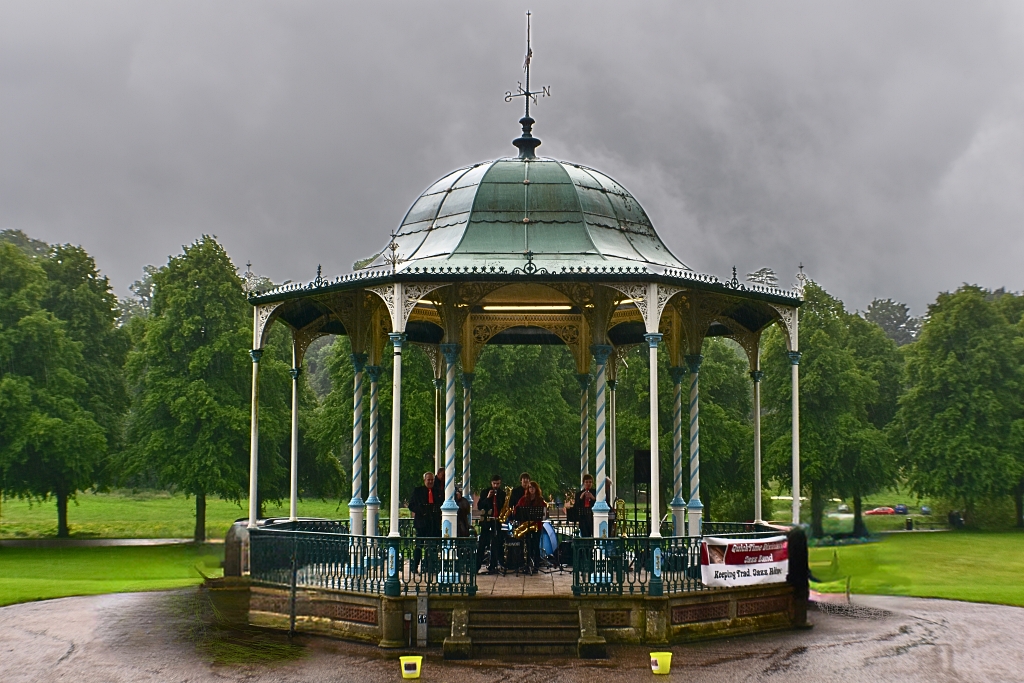 The Bandstand in Quarry Park © essentially-england.com
The Bandstand in Quarry Park © essentially-england.com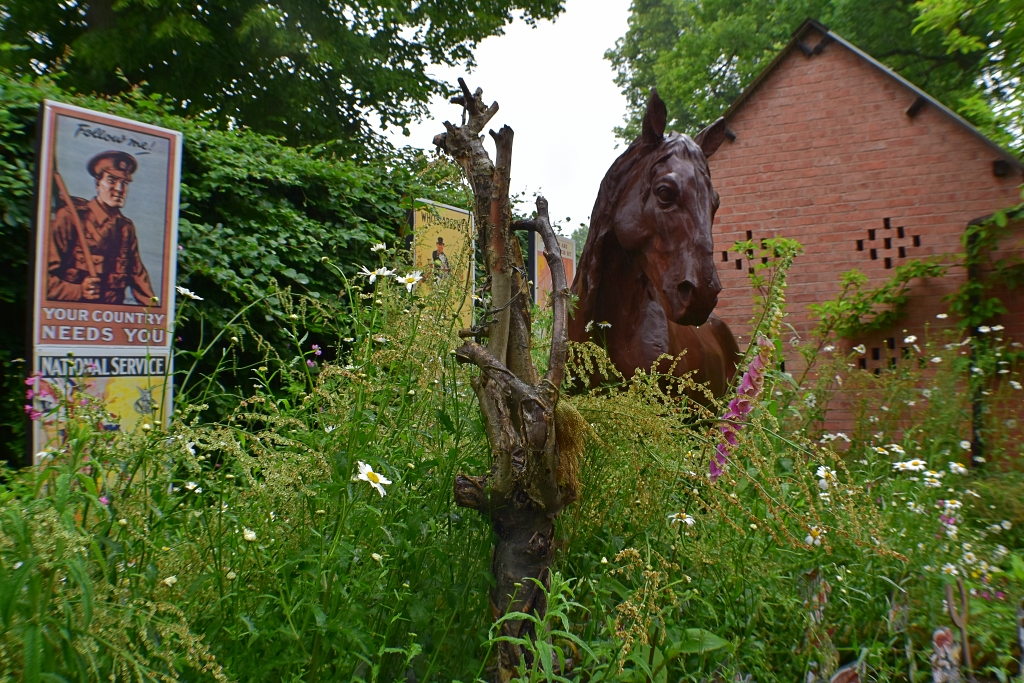 Views of the Dingle © essentially-england.com
Views of the Dingle © essentially-england.com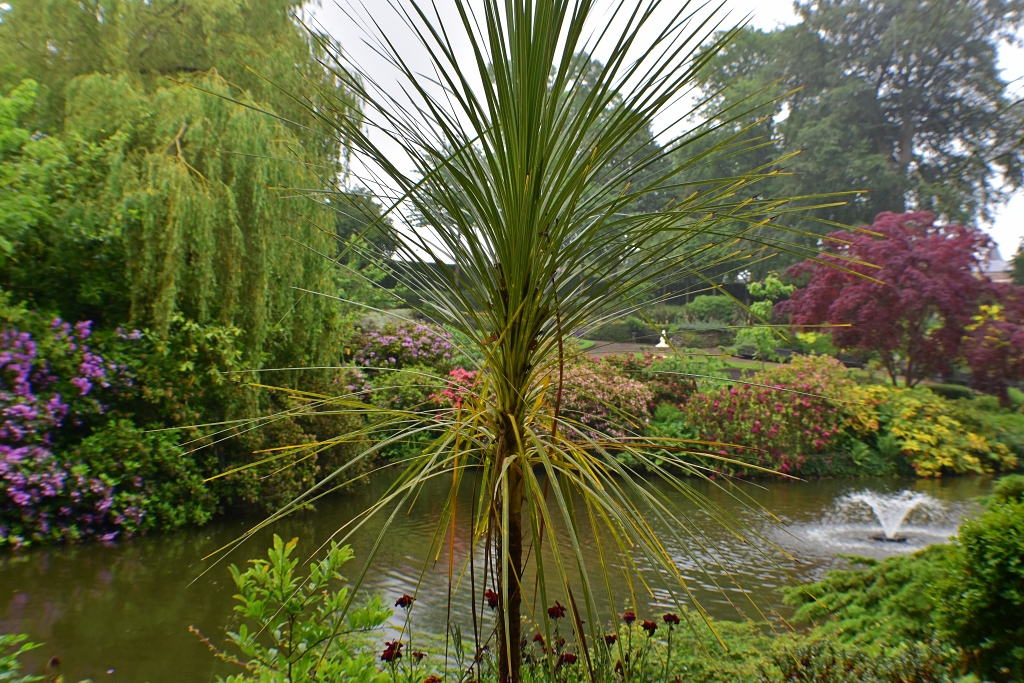 Views of the Dingle © essentially-england.com
Views of the Dingle © essentially-england.comThe centre piece of the park is The Dingle, which is a sunken garden designed by celebrity gardener Percy Thrower MBE, who was Parks Superintendent for 28 years. It’s a floral masterpiece of water features, bedding plants, and shrubs that made wandering around a pleasure, even on a wet day.
And before you think we're masochists - far from it! We were in the town on a Sunday, and despite the weather the park was very busy with the locals out in force to enjoy themselves.
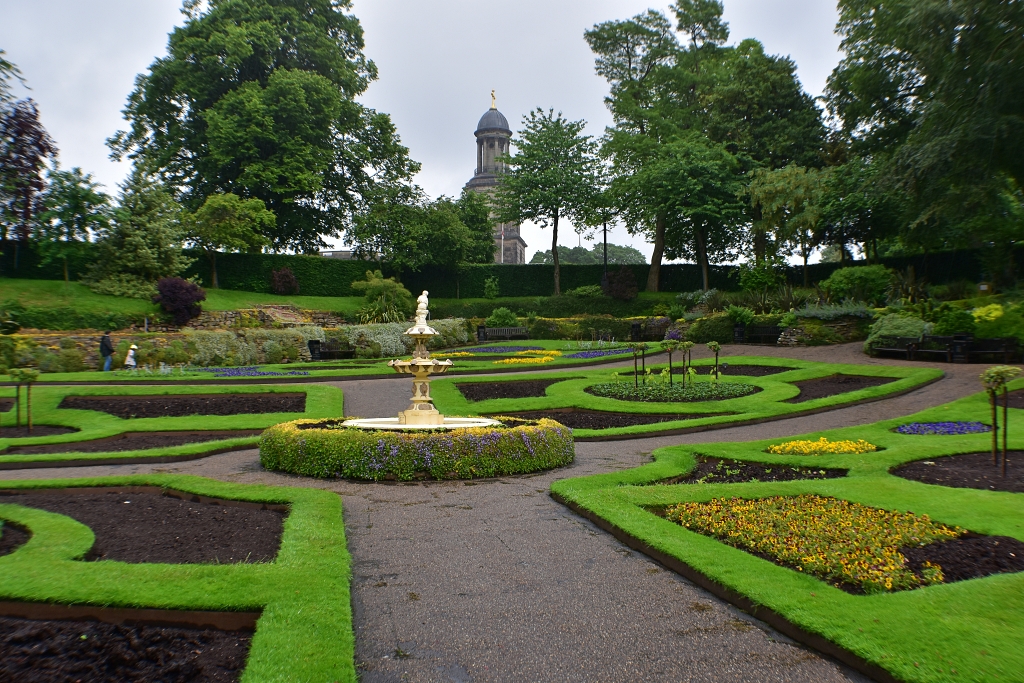 Views of the Dingle © essentially-england.com
Views of the Dingle © essentially-england.com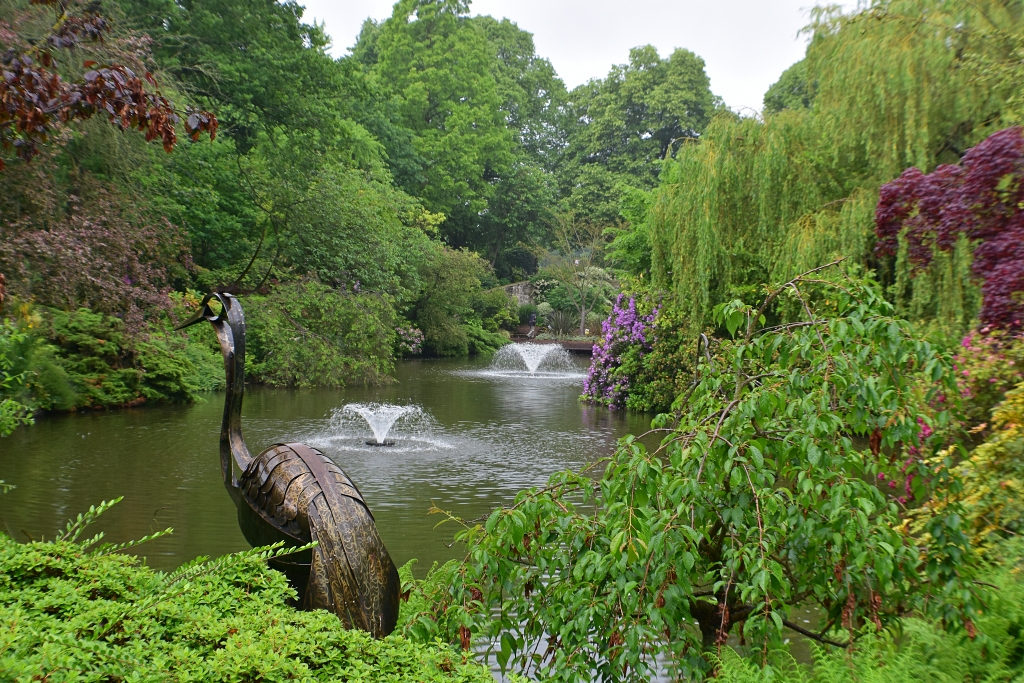 Views of the Dingle © essentially-england.com
Views of the Dingle © essentially-england.comPart of The Dingle is a water feature containing a statue of Sabrina the fabled goddess of the River Severn, which was donated to the town by The Earl of Bradford in 1879. The following words are on the base of the statue:-
Sabrina fair,
Listen where thou art sitting
Under the glassie, cool, translucent wave,
In twisted braids of lilies knitting
The loose train of thy amber-dropping hair;
Listen for dear honour’s sake,
Goddess of the silver lake,
Listen and save.
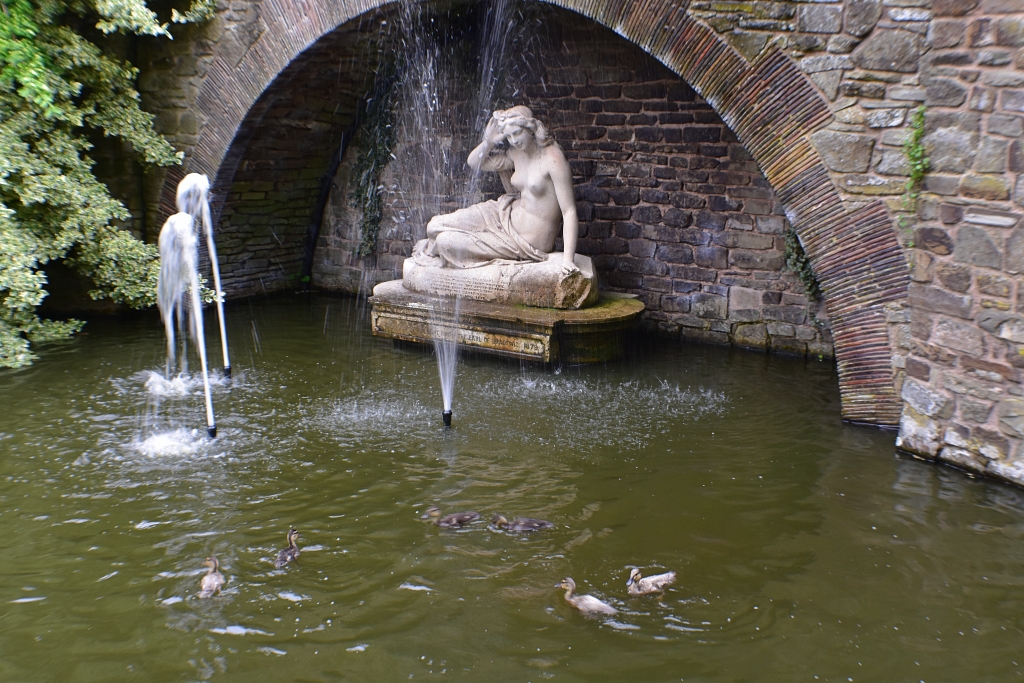 Sabrina, the Goddess of the Severn © essentially-england.com
Sabrina, the Goddess of the Severn © essentially-england.comThere are various myths and legends of how Sabrina became the goddess of the River Severn. None of them are happy legends, but very few such stories are. Sabrina wasn't martyred for her faith as many patron saints have been. Instead she may have been the innocent love child of Locrinus, King of England, who cheated on his wife Gwendolen with Sabrina's mother.
Gwendolen took this very much the wrong way. She raised an army, defeated her husband in battle and had his lover and their child drowned in the river. To add insult to injury, Gwendolen decided to name the river after the innocent girl. Sabrina is the Latin for Severn.
Our day out in Shrewsbury was definitely not long enough. There is plenty more to experience around this historic town. You could see the town from the boats that cruise the River Severn, explore the old prison, follow the Darwin Trail, and visit the site of the rather brutal 1403 Battle of Shrewsbury.
For further information on visiting Shrewsbury please use this link.
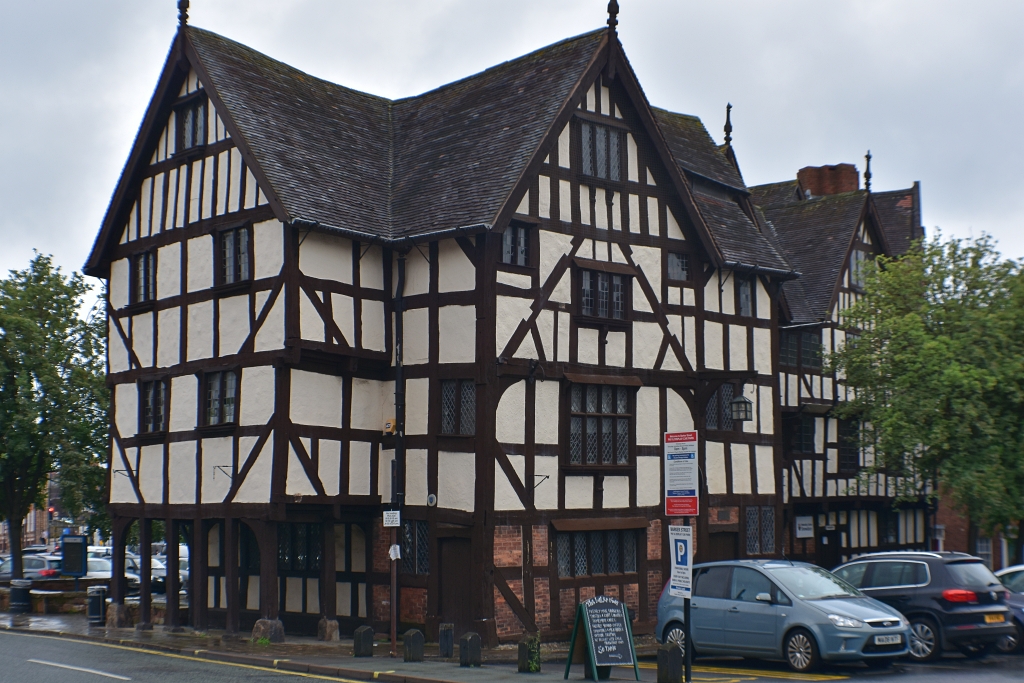 Timber-Framed Building in Shrewsbury © essentially-england.com
Timber-Framed Building in Shrewsbury © essentially-england.com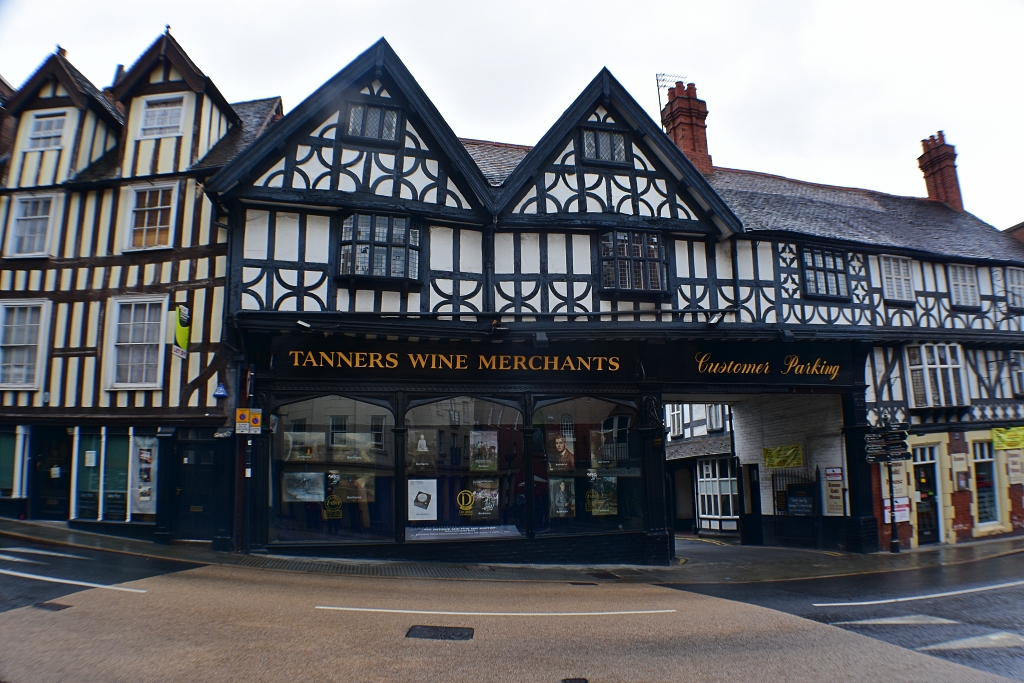 Timber-Framed Building in Shrewsbury © essentially-england.com
Timber-Framed Building in Shrewsbury © essentially-england.comAs far as food and drink are concerned... well, you’re in Shropshire, so the standard of fare available is excellent. A monthly farmers market is held in the town square, and a rather attractive bazaar selling quality produce in the Market Hall every Tuesday, Wednesday, Friday, and Saturday. There are the Salopian and Battlefield Breweries producing local beers and offering guided tours, and there is also a vineyard in Wroxeter producing local wine.
And even if you didn't come to Shropshire for a McDonalds, you should check out the restaurant on Pride Hill. It just happens to be the oldest building in the world housing a McDonalds! It also boasts part of the medieval town wall in the basement.
Are You Planning to Visit Shrewsbury?
This town is a marvellous place for history and food lovers! There's so much to see and do and taste, that you'll need more than just a short visit. Shrewsbury makes a great base with many historical sites in very easy reach and is surrounded by lovely countryside for walking or cycling.
You could stay in a cottage
If you need to find a hotel, then try one of these search platforms...
On our first visit to Shrewsbury we spent the weekend staying at the fabulous Albrighton Hall, and would strongly recommend it. Choose this hotel if you don't want all the noise of the town, as it is a couple of miles outside of Shrewsbury.
There's so much to in Shrewsbury, you'll be spoilt for choice. But if you need a few ideas, why not start exploring the town and castle before checking out Attingham Park, Wroxeter Roman City, Ironbridge Gorge, the Broseley Jitties, and Much Wenlock!
Click here for more great ideas of things to do in Shropshire.
For more Shropshire information and ideas for days out, please visit our Shropshire page.
